
Denna fredag, 9 augusti, 2019, Foto, anställda arbetar på Growing Home, Incs gård i Chicagos stadsdel Englewood. Atlanta, Chicago och andra stora städer över hela landet tar ett mångsidigt tillvägagångssätt för att föra hälsosam kost till "matöknar, " mestadels låginkomstkvarter som ligger mil bort från närmaste stormarknad. Deras initiativ inkluderar färskvarustånd vid masstransitstationer, stadsträdgårdar, och partnerskap med samåkningsföretag för att färja invånare till livsmedelsbutiker och bondemarknader. Målet är att minska hälsostörningar och stärka låginkomstsamhällen. (AP Photo/Amr Alfiky)
På hans väg hem, Darnell Eleby pausade innan han gick ombord på pendeltåget i Atlantas Five Points-station och manövrerade sin rullstol till ett stopp som inte syns på många kollektivtrafikplattformar:ett färskmatställ fyllt med färgglada frukter och grönsaker. Med hjälp av en volontär, han fyllde en korg med bananer, äpplen, majs och squash och betalas med en hälsoprogramkupong.
"Det hjälper dig när du inte kan komma till butiken, sa Eleby.
I Chicago, ideella grupper har öppnat hälsokliniker där personal förser patienter med näringsutbildning och gratiskuponger till marknader för areabönder som är fulla av hälsosam mat. Båda städerna har också uppmuntrat växande ansträngningar för att plantera stadsträdgårdar.
Stora städer över hela landet använder detta mångsidiga tillvägagångssätt för att föra hälsosamma kostvanor till "matöknar, " mestadels låginkomstkvarter som ligger mil bort från närmaste stormarknad. De hoppas inte bara minska antalet diabetes, högt blodtryck och fetma, men för att uppmuntra samhällsaktivism och egenmakt.
"Vi gör det här av ... ansvar gentemot vårt samhälle, Safia Rashid sa om trädgården hon och hennes man, Kamau Rashid, har vårdat på Chicagos South Side de senaste 14 åren.
Den 44-åriga mamman sa att paret började trädgårdsarbete när deras äldsta son var 3 år gammal, att bekämpa "matapartheid" ... folk som medvetet avvecklar denna gemenskap, ta bort hälsosam mat ifrån oss, Safia Rashid sa.
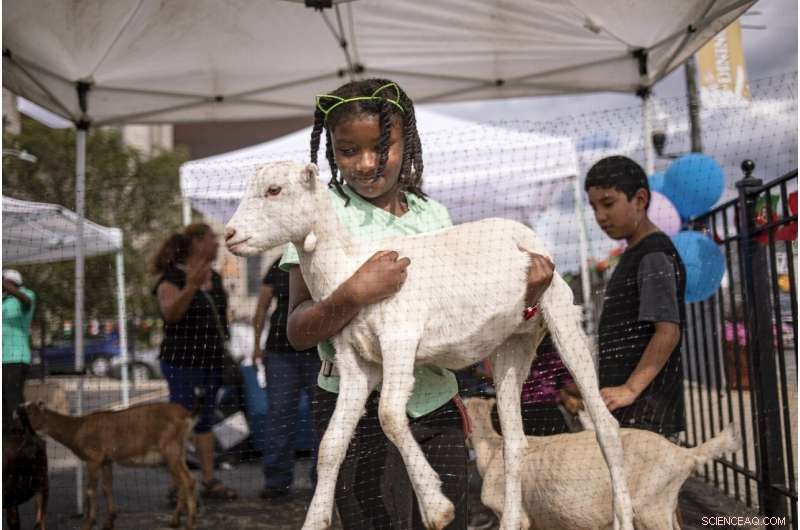
Denna fredag, 16 augusti, 2019, Foto, en flicka bär en get på Inner-city Muslim Action Networks (IMAN) bondemarknad i Chicago i Chicago i Chicago. Atlanta, Chicago och andra stora städer över hela landet tar ett mångsidigt tillvägagångssätt för att föra hälsosam kost till "matöknar, " mestadels låginkomstkvarter som ligger mil bort från närmaste stormarknad. Deras initiativ inkluderar färskvarustånd vid masstransitstationer, stadsträdgårdar, och partnerskap med samåkningsföretag för att färja invånare till livsmedelsbutiker och bondemarknader. Målet är att minska hälsostörningar och stärka låginkomstsamhällen. (AP Photo/Amr Alfiky)
Rashids trädgård växer på South Chicago Farm, en 14-acre (5,6-hektar) tomt som utvecklades 2015. Det är en av åtta sådana gårdar i Chicago som drivs av det ideella Urban Growers Collective.
I Atlanta, många av tomaterna, persikor och paprika som finns i papperskorgar på Fresh MARTA Markets kommer från mat som odlas i staden och närliggande gårdar, sa Hilary King, av de ideella Community Farmers Markets, som samarbetar med Metropolitan Atlanta Rapid Transit Authority för att driva montrarna. Lanserades 2015, MARTA-marknaderna finns på olika stationer under veckan.
"Vi kan inte lita på traditionella detaljhandelsmetoder, " sa Atlanta stadsjordbrukschef Mario Cambardella.
Ideella organisationer har också gått ihop med samåkningsföretaget Lyft för att ge upp till 300 låginkomstfamiljer rabatterade resor till bondemarknader och livsmedelsbutiker i Atlanta. Det sex månader långa pilotprogrammet, kallas Access AgLanta, började 1 juni inspirerad av ett liknande Lyft-partnerskap i Washington, D.C.
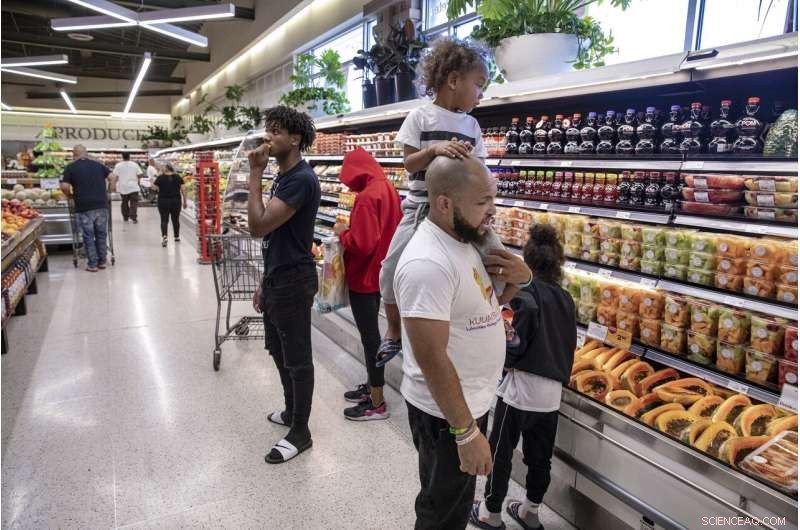
I denna torsdag, 15 augusti, 2019, Foto, Christopher "Mad Dog" Thomas, bär sin son, Rian Gatewood-Hillestad, medan du shoppar på Pete's Market i Chicagos Garfield Neighborhood. Thomas, som växte upp i stadsdelen Altgeld Gardens på Chicagos South Side, sa att han har lidit av "ätstörning i matöknen, ' där allt du har råd att äta är godis." Thomas och hans fru, göra en veckoresa utanför sitt grannskap till den här butiken, som hans fru beskriver som "the black or Hispanic Whole Foods." (AP Photo/Amr Alfiky)
"Vad vi ofta har hört genom åren är att transporter är ett stort hinder för tillgång till mat, sa Alysa Moore, programledare för Georgia Fresh For Less, vilket skaffar tillståndbosöttt, som mottar matkuponger med ekonomisk hjälp till shoppar hos bondemarknader.
Eleby är starkt beroende av marknaderna för transitplattformar. Utan dem, han sa, han skulle tvingas förlita sig på en liten spridning av butiker i hans låginkomstkvarter i sydvästra Atlanta där han sa att han måste lukta på mat eller undersöka den för mögel innan han köpte den. The food there, han sa, isn't "like it's supposed to be."
As of 2015, roughly 22% of Atlanta's population was living in a low-income community more than a mile from a food store, according to the U.S. Department of Agriculture.
In Chicago, that number is 5%. Comparatively, the number in Seattle is 7.8%; Washington, D.C., 6.4%; Baltimore, 4.3%; and Milwaukee, 3.5%, according to the USDA.
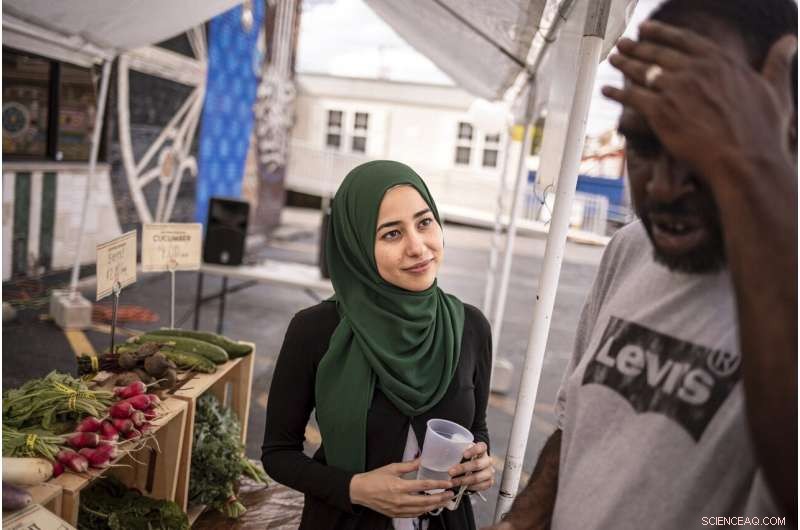
I denna måndag, Aug. 19, 2019, Foto, dietitian Heba Abdel Latief, höger, talks to her patient, Richard Ware, at Inner-city Muslim Action Network's (IMAN) farmers market in Chicago. IMAN offers free of charge dietitian visits at their health clinic. Atlanta, Chicago and other large cities across the country are taking a multi-pronged approach to bringing healthy diets to "food deserts, " mostly low-income neighborhoods located miles away from the nearest supermarket. The goal is to reduce health disorders and empower low-income communities. (AP Photo/Amr Alfiky)
Christopher "Mad Dog" Thomas, 34, who grew up in the Altgeld Gardens neighborhood on Chicago's South Side, said he has suffered from "'food desert eating disorder, ' where all you can afford to eat is candy."
Thomas and his wife, Kathryn Gatewood, make a weekly trip outside their neighborhood to a store called Pete's Supermarket, which Kathryn Gatewood describes as "the black or Hispanic Whole Foods."
"We spend almost 40% of our paychecks combined to ensure a healthier diet for our kids, " Hon sa, adding that it is a better alternative than buying bad food from the "dusty shelves" of corner stores in Englewood.
The Chicago nonprofit Inner-City Muslim Action Network has launched "The Corner Store Campaign" to change that.
Sami Defalla, who runs the Morgan Mini Mart in Englewood, has been an active partner with the campaign for more than two years. Defalla has created a "green zone" in the store where shoppers can purchase inexpensive fresh fruits and vegetables.
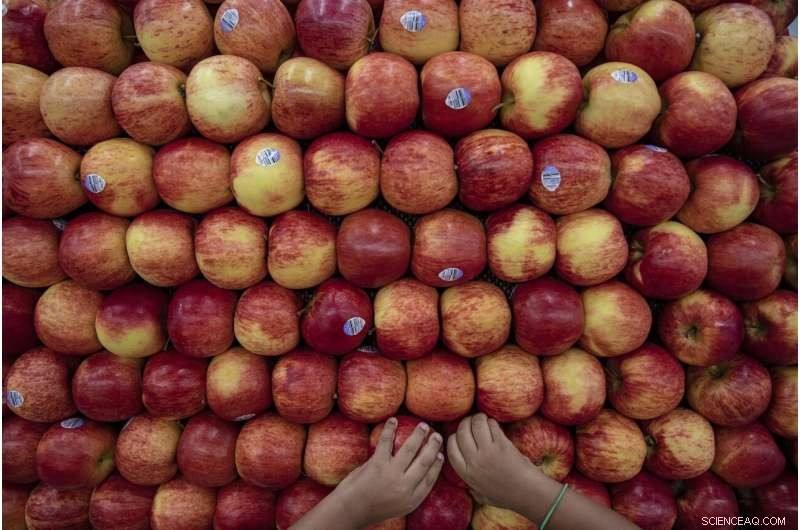
I denna torsdag, Aug. 15, 2019, Foto, Rian Gatewood-Hillestad plays with apples while shopping with his parents at Pete's Market in Chicago's Garfield Neighborhood. Christopher "Mad Dog" Thomas, Rian's father, organizes a weekly family trip outside their neighborhood to Pete's Supermarket, which his wife describes as "the black or Hispanic Whole Foods." (AP Photo/Amr Alfiky)
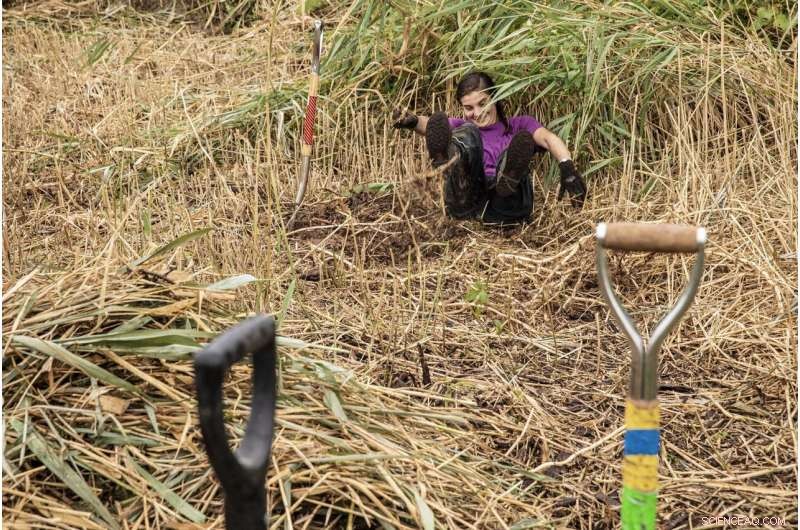
In this Saturday, Aug. 17, 2019, Foto, Viviana Gentry Fernandez-Pellon, co-founder of Cooperation Operation, smiles as she falls on her back while working to clear section of high weeds and brush to create a new space for an organic produce garden in the Pullman neighborhood of Chicago. Large cities across the country are using a multi-pronged approach to bring healthy diets to "food deserts, " mostly low-income neighborhoods located miles away from the nearest supermarket. They hope not only to reduce rates of diabetes, high blood pressure and obesity, but to encourage community activism and empowerment. (AP Photo/Amr Alfiky)
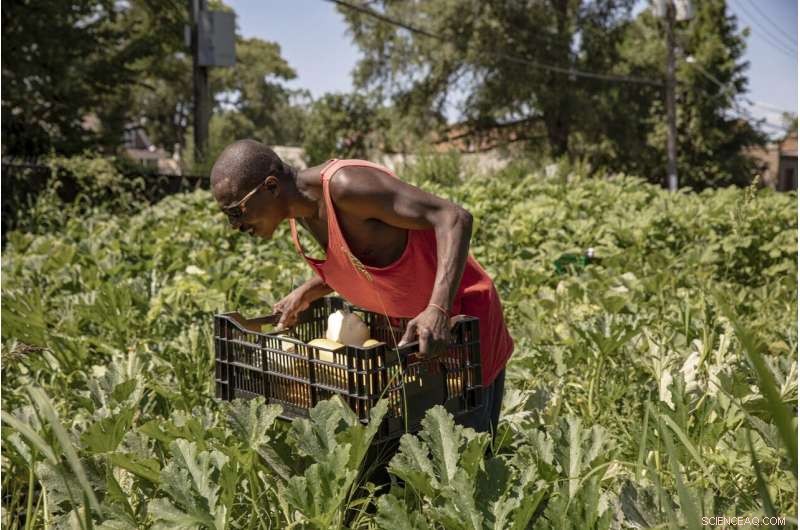
Denna fredag, Aug. 9, 2019, Foto, Stanford Williams works at the Growing Home, Inc. farm in Chicago's Englewood neighborhood. Large cities across the country are using a multi-pronged approach to bring healthy diets to "food deserts, " mostly low-income neighborhoods located miles away from the nearest supermarket. They hope not only to reduce rates of diabetes, high blood pressure and obesity, but to encourage community activism and empowerment. (AP Photo/Amr Alfiky)
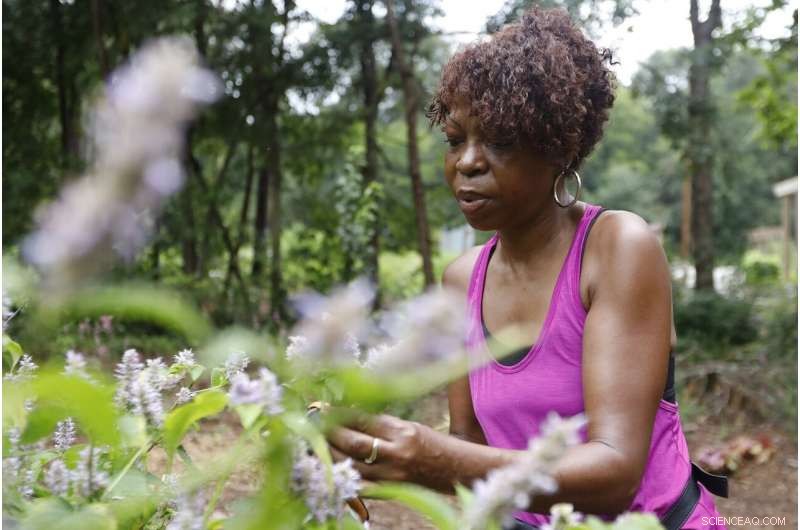
Denna fredag, July 19, 2019 foto, Celeste Lomax harvests anise hyssop plants in a community garden at the Urban Food Forest at Browns Mill in Atlanta. Lomax lives in a low-income neighborhood in south Atlanta with limited access to healthy food. She said the community gardens provide an alternative food source for volunteers and neighborhood residents. (AP Photo/Andrea Smith)
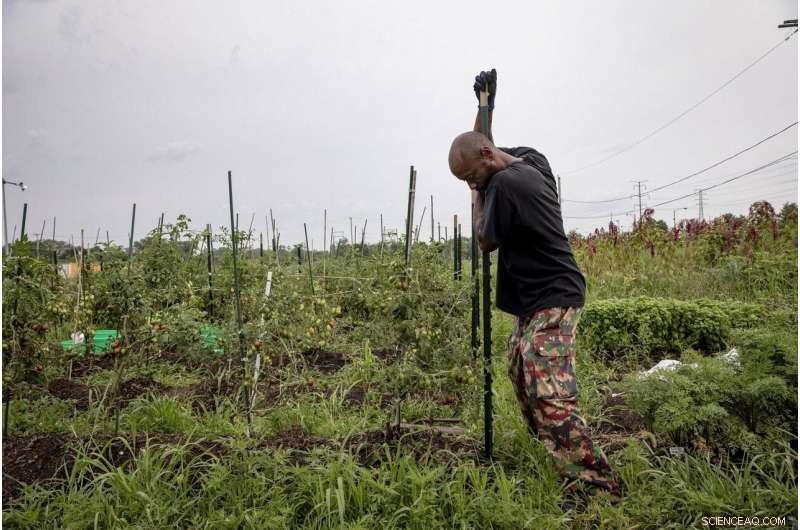
In this Tuesday, Aug. 20, 2019, Foto, Kamau Rashid works in his garden in the South Chicago Farm on Chicago's south side. Rashid and his wife Safia, started urban farming almost 14 years ago, when their oldest son was 3 years old. "We're doing this out of us feeling the need and responsibility toward our community." Safia Rashid, sa. Living in a neighborhood with little access to healthy foods, so-called food deserts, they set out to fight what they called "food apartheid." (AP Photo/Amr Alfiky)
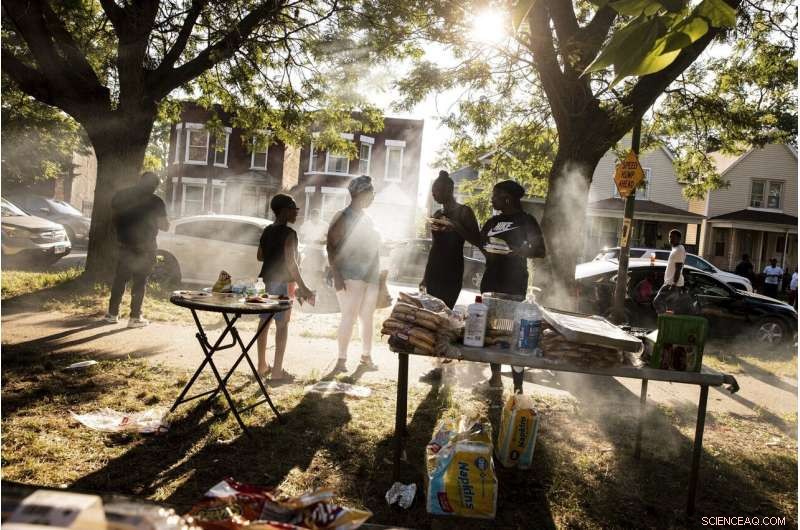
I denna torsdag, Aug. 1, 2019, Foto, people gather for a barbecue in a vacant lot hosted by Inner-city Muslim Action Network's (IMAN) in Chicago's neighborhood of West Englewood. IMAN seeks to educated people on proper nutrition in a section of the city with low access to nutritional foods. (AP Photo/Amr Alfiky)
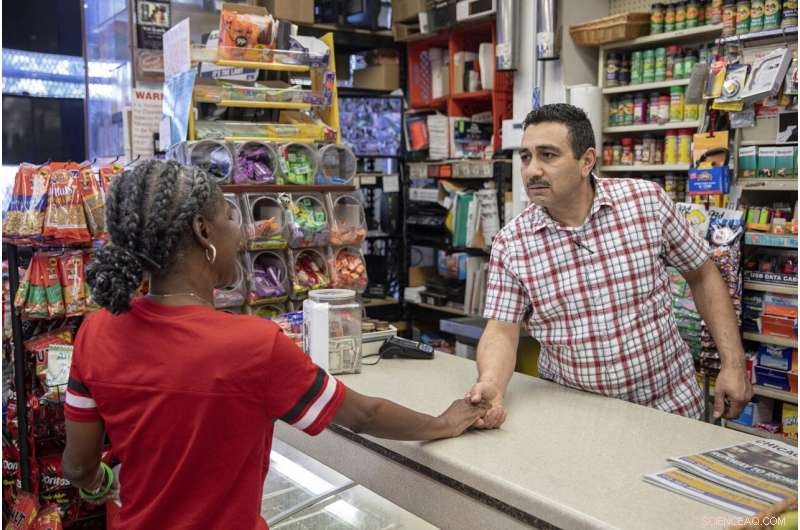
I denna måndag, Aug. 19, 2019, Foto, Sami Deffala, owner of the Morgan Mini Mart in Chicago's Englewood neighborhood, höger, offers his condolences to a customer who lost her 17-year-old son recently to gun violence in Ohio. Sami Defalla, who runs the small Mart in Englewood, has been an active partner with the campaign for more than two years. Defalla has created a "green zone" in the store where shoppers can purchase inexpensive fresh fruits and vegetables. (AP Photo/Amr Alfiky)
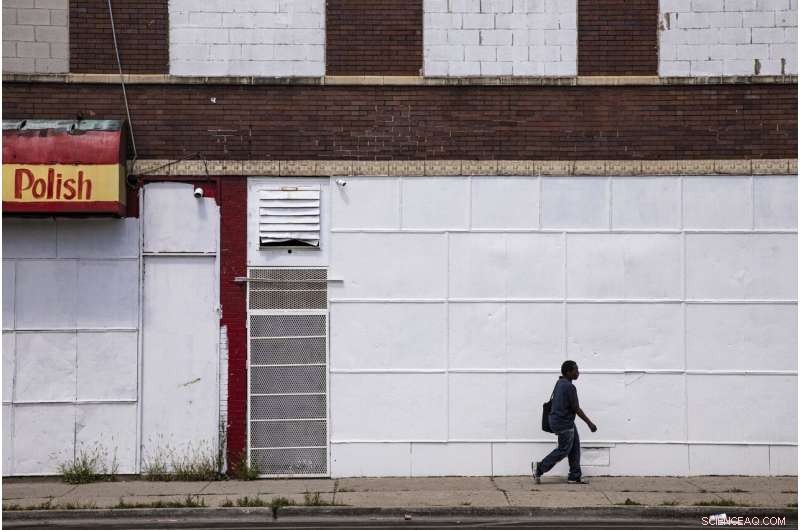
Denna fredag, Aug. 9, 2019, Foto, a man walks on a sidewalk past boarded up business in Chicago's Englewood neighborhood. As of 2015, roughly 22% of Atlanta's population was living in a low-income community more than a mile from a food store, and in Chicago, that number is 5%, according to the U.S. Department of Agriculture. (AP Photo/Amr Alfiky)
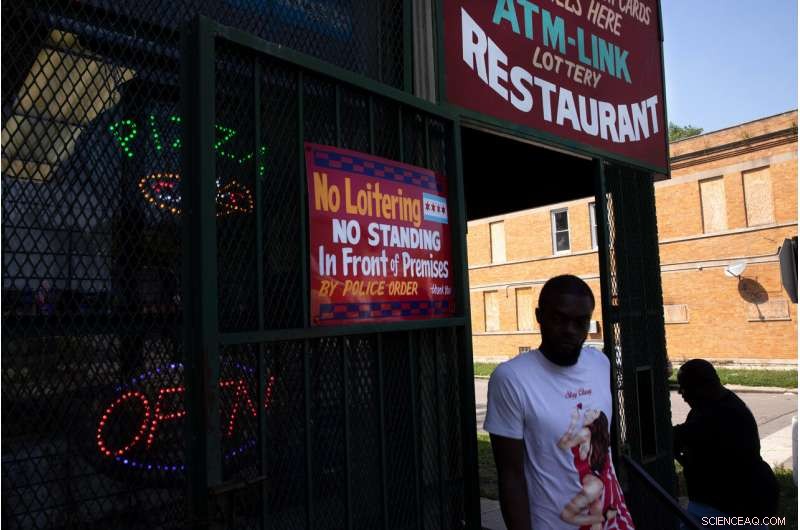
I denna måndag, Aug. 19, 2019, Foto, two people pass though the doorway of the Morgan Mini Mart in Chicago's Englewood neighborhood. Sami Defalla, who runs the Morgan Mini Mart in Englewood, has been an active partner with the campaign for more than two years. Defalla has created a "green zone" in the store where shoppers can purchase inexpensive fresh fruits and vegetables. (AP Photo/Amr Alfiky)
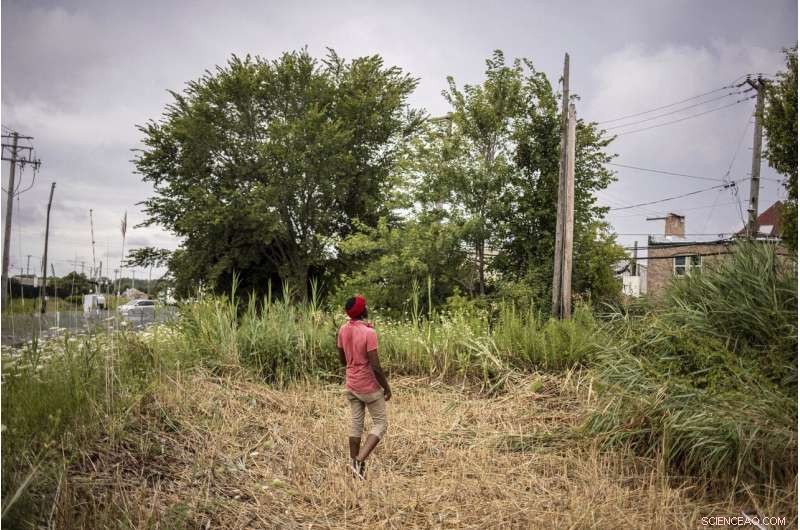
In this Saturday, Aug. 17, 2019, Foto, Olisaemeka Okakpu walks into a section of public land consisting of high weeds and brush, that his organization Cooperation Operation plan to clear for an organic produce garden in the Pullman neighborhood of Chicago. (AP Photo/Amr Alfiky)
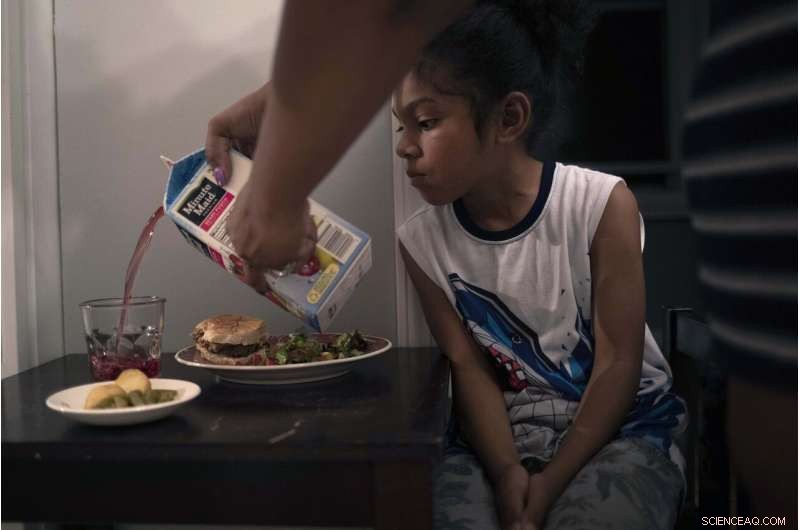
I denna torsdag, Aug. 15, 2019, Foto, Kathryn Gatewood pours juice into a glass for her son, Tracy at their home in Chicago's Englewood Neighborhood. "We spend almost 40% of our paychecks combined to ensure a healthier diet for our kids, " Hon sa, adding that it is a better alternative than buying bad food from the "dusty shelves" of corner stores in Englewood. (AP Photo/Amr Alfiky)
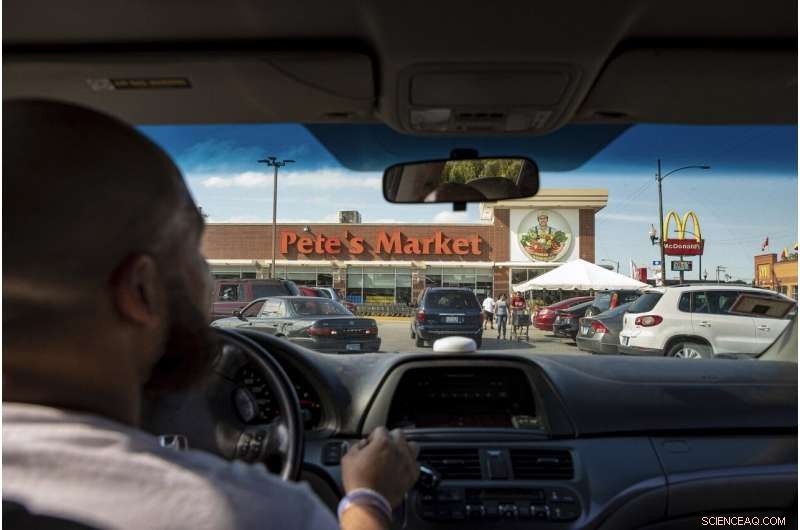
I denna torsdag, Aug.15, 2019, Foto, Christopher "Mad Dog" Thomas, drives into Pete's Market in Chicago's Garfield Neighborhood. Thomas organizes a weekly family trip outside their neighborhood to the store, which his wife describes as "the black or Hispanic Whole Foods." (AP Photo/Amr Alfiky)
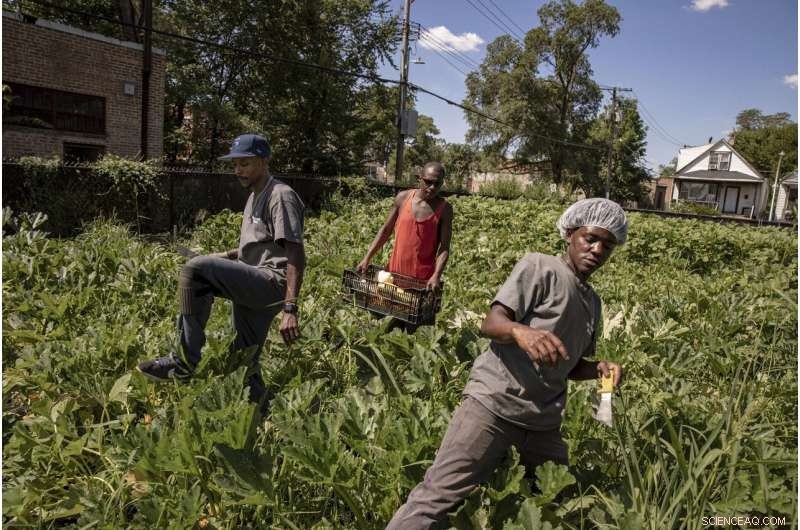
Denna fredag, Aug. 9, 2019, Foto, Maurice McCary, vänster, Stanford Williams, center and Torreyon Simmons, work at the Growing Home, Inc. farm in Chicago's Englewood neighborhood. Large cities across the country are using a multi-pronged approach to bring healthy diets to "food deserts, " mostly low-income neighborhoods located miles away from the nearest supermarket. They hope not only to reduce rates of diabetes, high blood pressure and obesity, but to encourage community activism and empowerment. (AP Photo/Amr Alfiky)
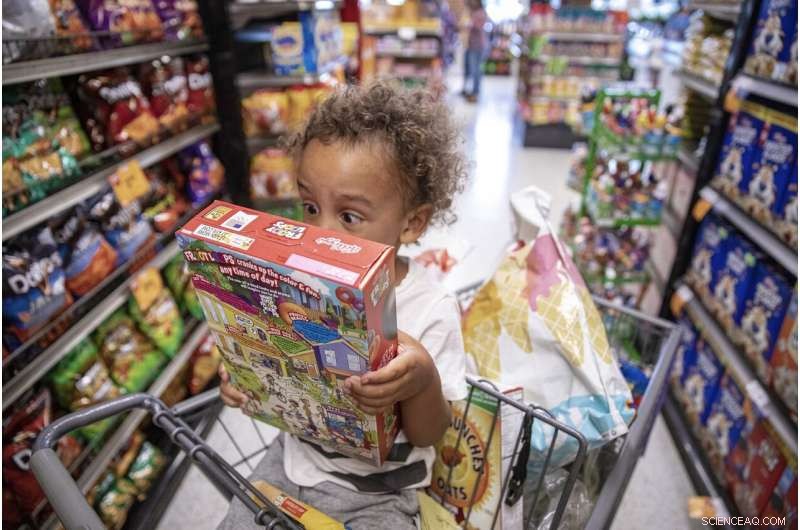
I denna torsdag, Aug. 15, 2019, Foto, Rian Gatewood-Hillestad reacts to cartoons printed on a cereal box while shopping with his parents at Pete's Market in Chicago's Garfield neighborhood. Christopher "Mad Dog" Thomas, Rian's father, organizes a weekly family trip outside their neighborhood to Pete's Supermarket, which his wife describes as "the black or Hispanic Whole Foods." (AP Photo/Amr Alfiky)
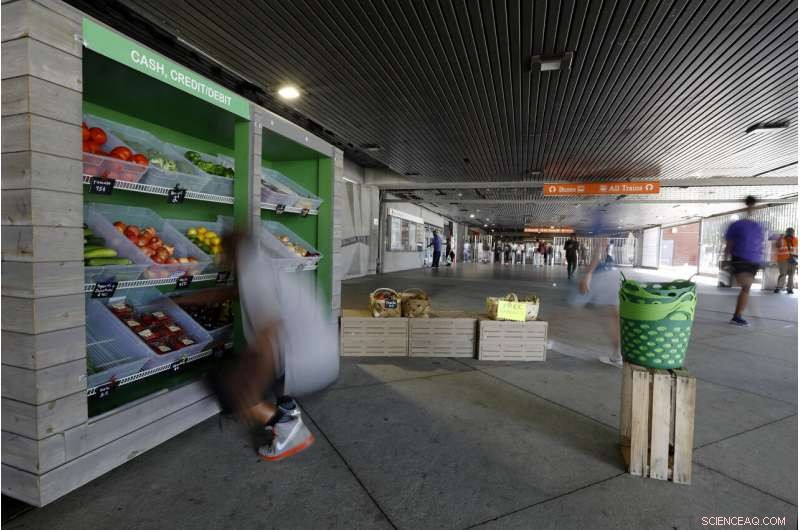
In this Tuesday, Aug. 20, 2019 foto, people pass by the Fresh MARTA Market in the West End transit station in Atlanta. The Metropolitan Atlanta Rapid Transit Authority and the Atlanta nonprofit Community Farmers Markets partner to run the stands, which sell food from some Atlanta urban farms. (AP Photo/Andrea Smith)
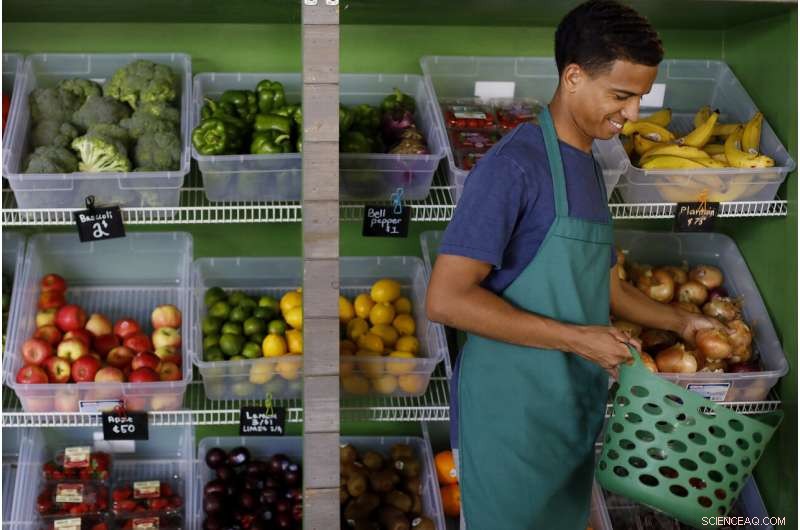
In this Tuesday, Aug. 20, 2019 foto, volunteer Xavier Lopez helps a customer select fruits and vegetables at the Fresh MARTA Market at the West End transit station in Atlanta. The Metropolitan Atlanta Rapid Transit Authority and the Atlanta nonprofit Community Farmers Markets partner to run the stands, which provide a healthy food source for people living in food deserts.(AP Photo/Andrea Smith)
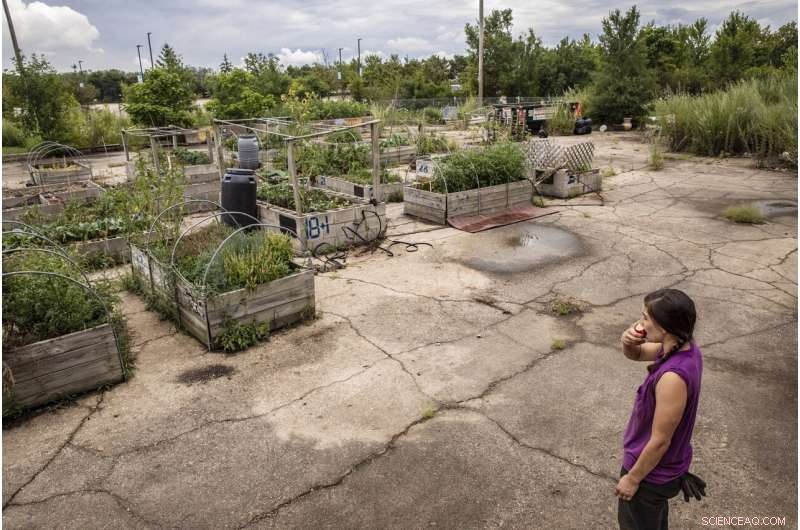
In this Saturday, Aug. 17, 2019, Foto, Viviana Gentry Fernandez-Pellon, co-founder of Cooperation Operation, eats an apple as she looks over the successful urban community garden in Chicago's Pullman neighborhood. (AP Photo/Amr Alfiky)
"I wish I had a bigger platform to offer more ... to my customers, " Deffala said.
The Muslim Action Network also operates a health clinic where patients can see a dietitian free of charge and receive coupons for free produce at the nearby farmers market. Every Friday, the group hosts a farmers market where residents can connect with local urban farmers.
As a volunteer in a community garden in Atlanta, Celeste Lomax is finally able to take fresh produce home to her low-income neighborhood, which is located about 4 miles (6.4 kilometers) away from the nearest supermarket.
"We have a right to eat healthy like everyone else does, " Hon sa.
© 2019 Associated Press. Alla rättigheter förbehållna.